Background: According to standard physics we cannot travel to the stars in a human lifetime because we need impractical amounts of fuel to get close to light speed. However, a new theory of inertia has been proposed called Quantized Inertia (QI). It predicts standard inertia, as a vacuum effect, at normal accelerations. It also predicts a drop in inertia at low accelerations that predicts disc galaxy rotation without dark matter. Therefore it has solid empirical backing.
Objective: Quantized inertia predicts that a new kind of propulsion can be achieved by energizing the vacuum and making gradients in it using synthetic ‘horizons’ (conductive materials). This form of propulsion does not need heavy fuel, only an energy source, so it would allow interstellar travel in a human lifetime. DARPA funded lab work 2018-2022 to demonstrate this prediction unambiguously in the lab.
Method: $1.3M was won from DARPA to test this prediction and a network of, so far, six labs have joined the effort, formerly and informally. The methods used include firing lasers into asymmetric metal cavities, lasers into fibre-optic flouride glass loops shielded by metal on one side, high-acceleration electrons in capacitors, and other methods.
The IVO system uses the capacitor cavity method.
In 2023, they are getting good results from a capacitor with a dielectric between plates with 8 micron separation. McCulloch uses Aluminium plates and kapton dielectric but IVO Ltd experiment uses a solid dielectric. There are at least three groups working on the propulsion experiments and six labs worked on ground experiments. In Mike McCulluch lab at Plymouth, they saw 0.25 milliNewtons. IVO saw 52milliNewtons. All of the works is at about 1 watt of power because attempts to increase power causes problems at this time. There is still times when the system does not work.
Results: In 2021, one experiment had shown no thrust but several others have measured the thrust expected from the theory, with force to power ratios of for example 0.08 N/kW (comparable to ion drives, without needing fuel) and up to 100 N/kW (enough to enable launch). NOTE: that the most power is 1 watt systems with about 52 millinewtons.
NOW- The company IVO Ltd and DARPA want to confirm that the lab results are real. The Quantized Inertia drive has been launched into space and has been there for over two months. It has been outgassing so that any propulsive effect will be from the drive. They have also been performing the null tests and establishing a baseline that would be changed if the propulsion is working. The mission and drive are in a low power cube sat but if the ground work propulsion happens in space then over a few weeks or a few months the drive will be able to move the cube sat from low earth orbit up to geosynchronous. There would be no other way to explain than the propulsion works.
Conclusion: If the orbital test gives positive results and can be replicated and confirmed and the work scaled then interstellar travel within a human lifetime becomes possible. The 2021 talk will present the quantized inertia theory, the evidence for it, the experimental thruster results so far (where possible) and an outline of a QI-based interstellar propulsion system (horizon drive).
The drive method deployed into space is likely the laser fired into flouride gas fibre-optic loops shielded by metal on one side or is lasers fired into asymmetric metal cavities.
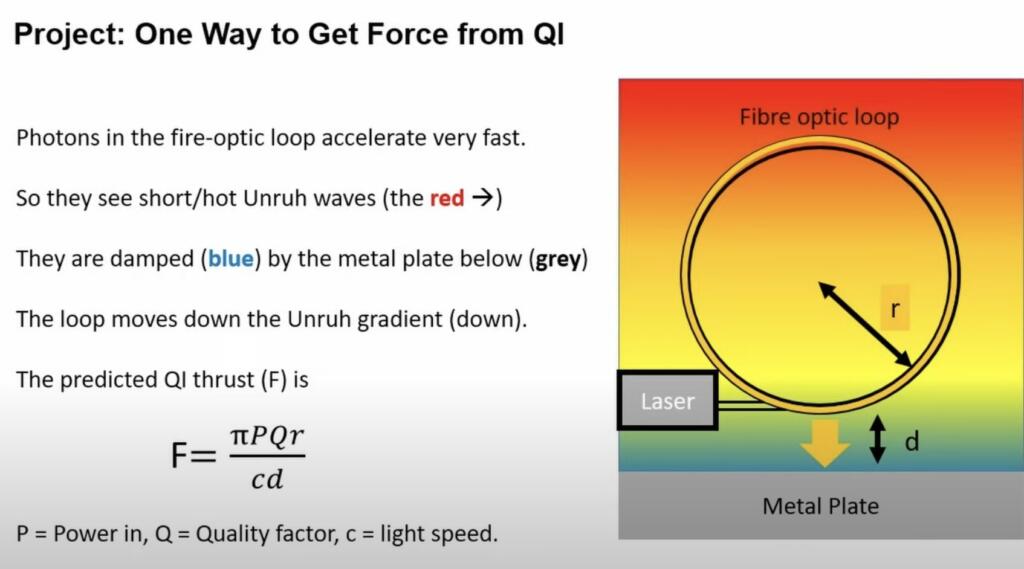
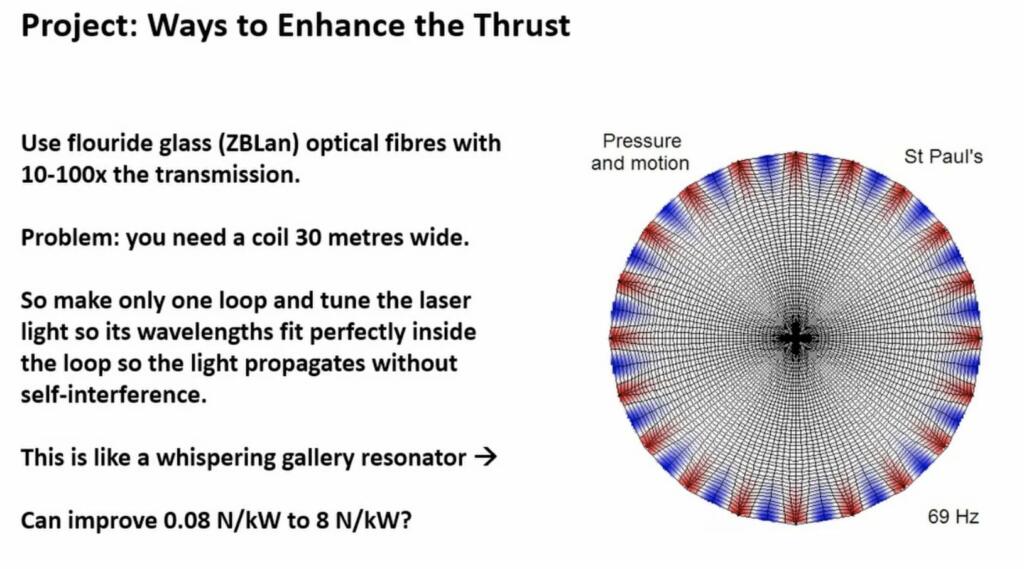


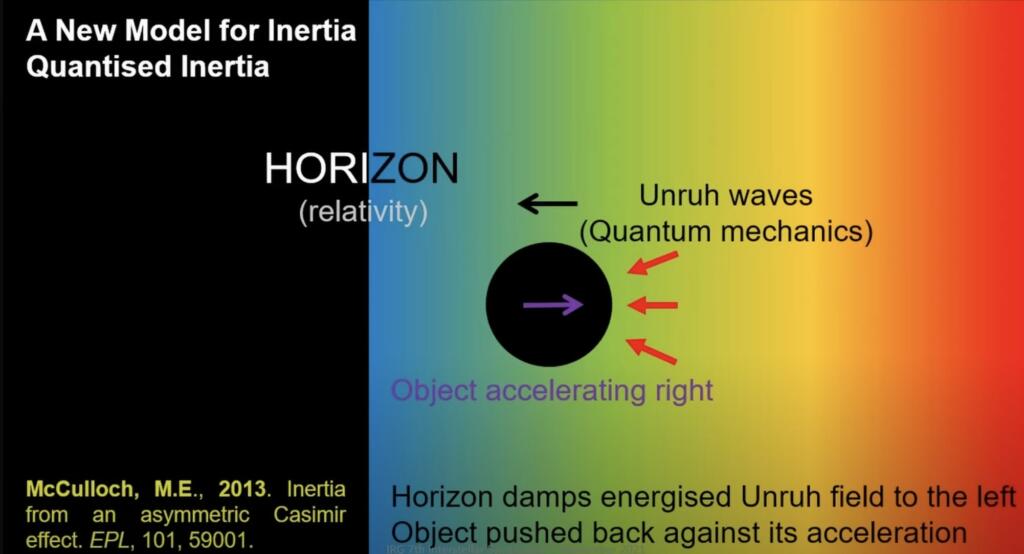
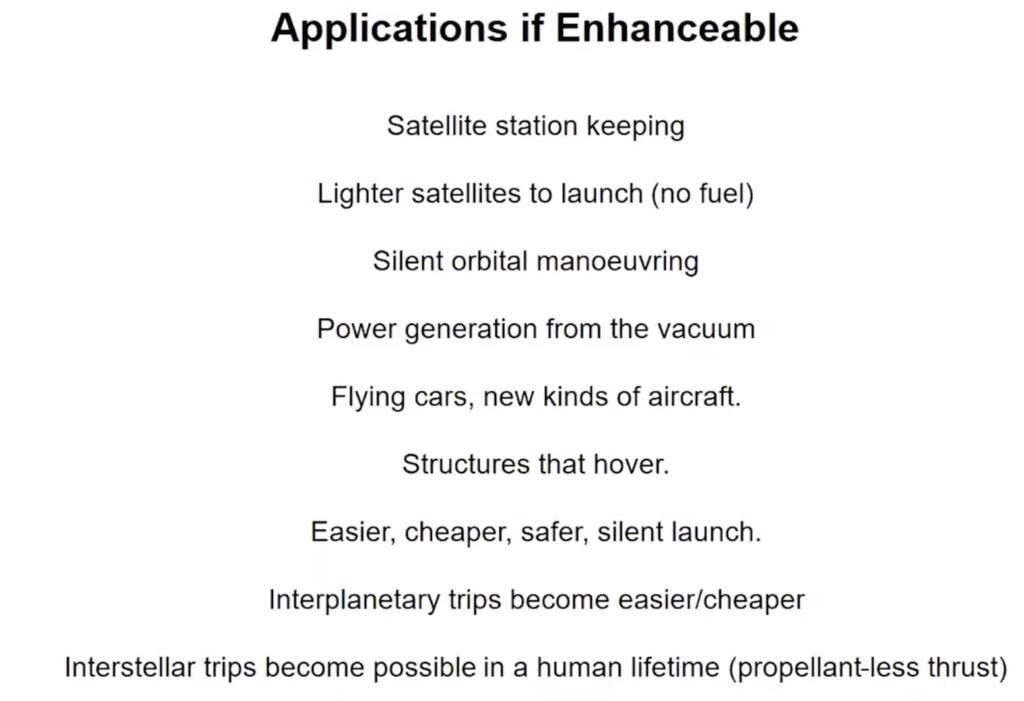


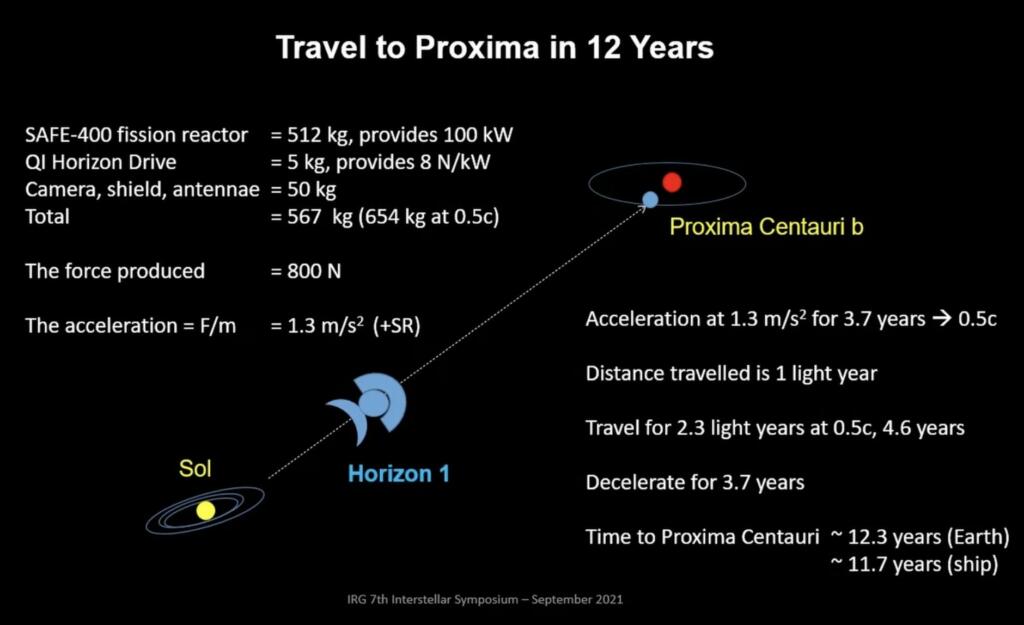



Brian Wang is a Futurist Thought Leader and a popular Science blogger with 1 million readers per month. His blog Nextbigfuture.com is ranked #1 Science News Blog. It covers many disruptive technology and trends including Space, Robotics, Artificial Intelligence, Medicine, Anti-aging Biotechnology, and Nanotechnology.
Known for identifying cutting edge technologies, he is currently a Co-Founder of a startup and fundraiser for high potential early-stage companies. He is the Head of Research for Allocations for deep technology investments and an Angel Investor at Space Angels.
A frequent speaker at corporations, he has been a TEDx speaker, a Singularity University speaker and guest at numerous interviews for radio and podcasts. He is open to public speaking and advising engagements.


There are three layers to nature.
1/ Particles (all that physicists care about).
2/ Aether (or Spacetime, the fabric of “space”), think of “Gravity Waves”.
3/ Hyperspace (the void, which is dimensionless).
So, UFO travel is via “wormholes”, tunnels in the Aether, “faster than light speeds” are no problem.
The energy to “fly” their craft comes directly from stars via wormholes. They do not carry a “power plant”.
Their craft do not emit “thrust” (Newton-3), they “translate” from point to point via “displacement” (Ernst Mach’s already published Theory).
The last one should be very obvious. The maths of “fluid dynamics” completely cover “movement” within the Aether.
Do remember well, “Mathematics” is a prison for minds without vision!
If the quantized inertial device works, it is pushed by virtual particles, so it should work without any power source. How is electric energy used to increase this effect – or any source of energy?
As far as I understand, it isn’t getting energy from virtual particles, but from “the Unruh waves” resulting from the loss of information by the expanding cosmos. The author makes the analogy of the cosmic horizon to a black hole emitting hawking radiation, and Unruh waves are the result of that, changing in force as you accelerate or decelerate. How the far away ende of the cosmos knows about any movement here is beyond me, but that’s the gist of it.
And the author actually posits self propelling, zero energy consumption solid-state materials.
The energy here is used to create the effect, but it ought to work with nanocavities of certain geometry and size too, within the current capabilities of semiconductor photolithography, curiously.
If this thing extracts energy from the vacuum to produce thrust, wouldn’t this also be useful for power generation on Earth? Pretty skeptical.
And if it is extracting energy from the vacuum, how and why are other power sources being used to enhance performance? It should allow a perpetual motion device.
Who was the strong argument against the EM drive.
For any constant trust engine, have them on an axis in an vacuum chamber will increase rotation speed linearly as trust is constant.
But potential energy increases was velocity^2 so at some point potential energy increases faster than energy supplied. Keep going an then tap extra energy.
A cars acceleration slows down as it go faster, not only because air resistance and engine loss increase but because you have to put more energy into the car.
Same with guns or trains.
Rockets escapes this because they first has to accelerate the reaction mass before using it.
Unlike previous reactionless drives, this one has quickly gone to the obvious test of putting it in a small satellite with no other possible way of changing it’s orbit and trying to change the orbit with it.
I thought the drive method deployed to space by IVO is asymmetrical capacitors.
By the way, why is it that everybody testing a hypothesized effect that can maybe be detected by sensitive instrumentation immediately extrapolates it to interstellar travel at relativistic speeds?
because the mind traveld faster than the speed of light.
Ugh, IKR? Dial up the juice here on earth 1000x and see what happens.
More expensive and time consuming than putting the existing system to space. $350k for the ride into space.
Plenty of companies have spent tens of millions trying to scale proven low power propulsion, Ad Astra company working on the VASIMR. 12-15 years for MIT lab work.
SpaceX rapidly iterates with live tests, instead overspending on simulation or non-launch or non-orbit tests.
This, not saying this will work but its often an better way to do it.
Wait, you can shield Unruh radiation? With a macroscopic shield? What’s it made of, Cavorite?
This concept has so many problems I don’t know where to start.
OK, first, Unruh radiation is an interaction between an accelerating particle and the quantum vacuum. The accelerating particle directly interacts with the quantum vacuum in such a way that it effectively “sees” the Unruh radiation. In some ways it’s like the Lamb shift in hydrogen atoms.
The Unruh radiation isn’t classical EM radiation present around the particle, only the accelerating particle itself interacts with it, so you wouldn’t be able to damp it with an external metal plate.
I mean, if an external metal plate could damp it, you could just set up a fiber optic loop and detect that radiation with perfectly ordinary classical instrumentation, like a “glow” around the fiber. Nobody has seen anything like that, because there’s nothing outside the fiber to interact with. It’s purely an interaction between the particle and the vacuum.
Heck, if Unruh radiation were actual external EM radiation, you could reduce inertial mass by putting a Faraday cage around something! The insides of conductive objects would have reduced inertial mass. There are all sorts of real world effects that you’d see, and you don’t see them! It can’t be anything that a physical barrier could “damp”, or else inertial would behave differently!
And where is the energy coming from for this EM field? The circulating light in the low loss fiber optic loop? Does it red shift, or something like that?
Setting that aside, a bit of text in the illustration drew my eye: “Feasible if the receiving area AR is Sol system wide, and gamma rays are used”
Um, say what? Could we have a bit of clarification concerning that? Because that kind of rang some alarm bells for me.
The idea is that the waves are so short that the “shield” becomes an effective horizon, invoking the Casimir effect. If the waves are too long to exist between the particle and the horizon, they are blocked and an asymmetric force is produced. Or something like that.
However, the ring laser described above isn’t how IVO’s drive supposedly works, it’s a capacitive device, so may be even farther-fetched.
But Unruh radiation can’t both be the source of inertia AND capable of being blocked by adjacent objects, because we know for an absolute fact that inertia doesn’t behave that way.
Do we? It’s only predicted under QI that the Unruh waves become short enough to interact with macroscopic objects, so it’d be quite easy to miss.
*at extreme accelerations, sorry. Even the particles travelling around the LHC only experience a few thousand g, whereas the electrons tunnelling across a microscopic barrier experience far more for a very brief time.
In fact, particles traveling around even a modest cyclotron, such as you might find in a college physics lab, are traveling close enough to the speed of light to experience basically the same acceleration as the light in the proposed QI drive. AND they’re, conveniently, surrounded by a metal pipe!
I’m pretty sure that particle physicists would have noticed variations in inertia in such particles that depended on where they were located inside the beam tube. They’re measuring that behavior pretty closely, after all.
I would also expect shielding effects to be visible in gravitational wave chirps from neutron stars spiraling into a collision. The acceleration is a little lower, but the scale larger; We don’t see any sign that the interior of these neutron stars are experiencing lower inertia as the acceleration increases.
Further, if you can dampen Unruh waves with a metal plate, they must interact with the metal plate, which implies that they’re detectable waves. And they’d be present around every laser gyroscope.
This doesn’t mean QI is a bust. But the waves we’re talking about are a kind of virtual wave that interacts only with the accelerating particle, it’s really an interaction with the quantum vacuum, not the EM field, there’s nothing going on outside the particle to interact with.
But, of course, experiments trump everything else, and if it works? “E pur si muove”. I’d love for it to work, even if it wasn’t practical as a space drive, just for the new physics.
If this is real, then the Fermi Paradox mystery becomes even deeper.
Even 0.08N/kW thrust should be easily measurable in the lab. Just stick a 100kW power supply to it and watch it accelerate to 8 m/s. What is the deal?
You’d have to distinguish between the acceleration due to the Unruh effect, and the acceleration due to the apparatus exploding. That’s tricky.
Most things will accelerate to 8 m/s if you hook 100kW up to it.
I know I will!